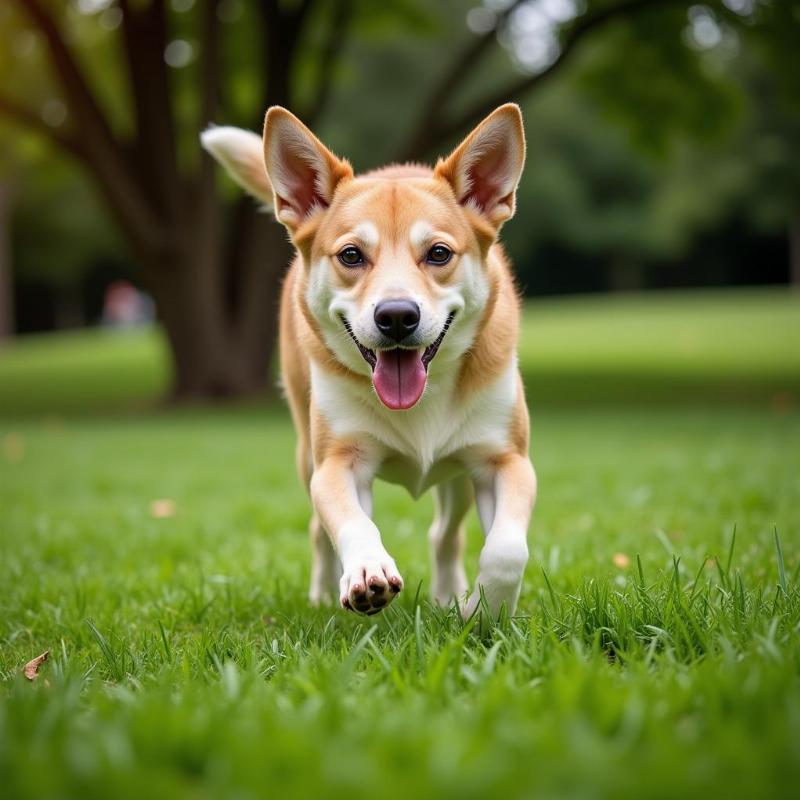Keeping your furry friend safe is a top priority for any dog owner, and that includes protecting them from the potential dangers of weed killers. If you’ve recently treated your lawn, you’re likely wondering, “How long to keep dog off grass after weed killer?” The answer depends on several factors, including the type of weed killer used, weather conditions, and your dog’s size and sensitivity. Understanding these factors is crucial for responsible pet ownership in the US.
Understanding Weed Killer Ingredients and Their Impact on Dogs
Different weed killers contain different active ingredients, some of which can be toxic to dogs. Common culprits include glyphosate, 2,4-D, and mecoprop. These chemicals can cause a range of symptoms, from mild skin irritation to more serious issues like vomiting, diarrhea, and even neurological problems. Always check the product label for specific warnings and precautions. Even products marketed as “pet-safe” should be used with caution, as they may still contain ingredients that can irritate sensitive dogs.
Deciphering the Waiting Period: How Long is Long Enough?
Most weed killer labels recommend keeping pets off the treated area until the product has dried completely. However, this is often not sufficient to ensure your dog’s safety. A general rule of thumb is to wait at least 24-72 hours, but it’s always best to err on the side of caution. For certain potent herbicides, the waiting period could extend up to several weeks. Consult a veterinarian for specific recommendations based on the product used and your dog’s individual health profile.
Protecting Your Pup: Safe Lawn Care Practices
Protecting your dog from weed killer involves more than just waiting for it to dry. Consider using organic weed control methods, such as hand-pulling weeds or using corn gluten meal as a natural pre-emergent herbicide. These methods are generally safer for pets and the environment. If you must use chemical weed killers, choose products specifically labeled as safe for pets and follow the instructions carefully. Always store weed killers out of reach of children and pets.
Recognizing Signs of Weed Killer Poisoning in Dogs
Even with precautions, accidents can happen. It’s essential to be aware of the signs of weed killer poisoning in dogs, which can include excessive drooling, vomiting, diarrhea, lethargy, tremors, and difficulty breathing. If you notice any of these symptoms after your dog has been exposed to weed killer, contact your veterinarian or the ASPCA Animal Poison Control Center immediately. Prompt veterinary care can be life-saving.
Creating a Dog-Friendly Lawn: Tips and Tricks
Creating a dog-friendly lawn requires a holistic approach. Proper lawn maintenance, including regular mowing and fertilization, can help reduce the need for weed killers. Providing designated potty areas and training your dog to use them can also minimize their exposure to treated areas. Remember, a healthy lawn is a happy lawn, and a happy lawn is a safe space for your beloved canine companion.
 Dog Playing on a Healthy Lawn
Dog Playing on a Healthy Lawn
Conclusion: Prioritizing Your Dog’s Safety After Weed Killer Application
Understanding how long to keep your dog off grass after weed killer application is crucial for responsible pet ownership. By following the guidelines on the product label, consulting with your veterinarian, and considering safer alternatives, you can ensure your dog’s health and happiness while maintaining a beautiful lawn. Prioritizing their safety is not just about how long they stay off the grass, but also about making informed choices about lawn care practices.
FAQ:
- What are the common signs of weed killer poisoning in dogs? Common signs include vomiting, diarrhea, lethargy, tremors, and difficulty breathing.
- Are there pet-safe weed killers available? Yes, some products are marketed as pet-safe, but always use them with caution.
- What should I do if my dog gets into weed killer? Contact your veterinarian or the ASPCA Animal Poison Control Center immediately.
- How can I minimize my dog’s exposure to weed killer? Use organic weed control methods, create designated potty areas, and train your dog accordingly.
- How long should I wait to let my dog on the grass after applying granular weed killer? Follow the product label instructions, and err on the side of caution by waiting longer than the recommended time.
- Can I use vinegar as a dog-safe weed killer? While vinegar can kill weeds, it can also alter the soil pH, so use it sparingly.
- What are some organic weed control methods? Hand-pulling weeds, using corn gluten meal, and applying boiling water are some effective options.
Related Articles:
- how long after fertilizing can i let my dog out
- weed killer that won't kill grass and safe for dogs
- how long before dogs can go on treated lawn
- is weed killer safe for dogs
- dog friendly weed and grass killer
Beautdogs.us is your premier online resource for comprehensive dog care information, breed-specific advice, and the latest in pet products and services. Whether you’re a new dog owner or a seasoned pro, Beautdogs.us is your trusted partner in navigating the exciting world of dog companionship. We offer expert guidance on everything from nutrition and training to health and grooming, ensuring you have all the tools to provide the best possible care for your furry friend. Contact us today for personalized support and expert advice! Email: [email protected], Phone: +1 501-555-7529. Visit us at Beautdogs.us for more valuable insights and tips!